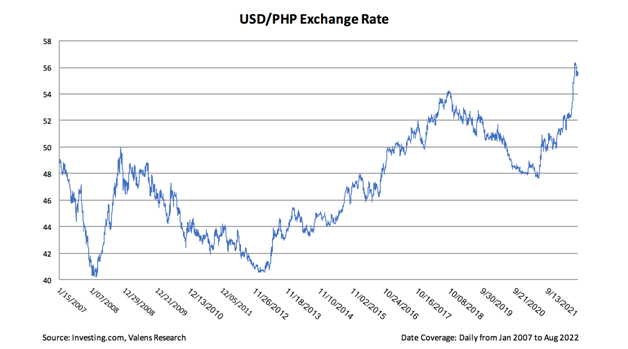MONDAY MACRO: The depreciation of the peso continues to be an impediment to the Philippines’ economic growth

The Philippine peso has been depreciating relative to the U.S. dollar over the past year owing to certain global and domestic macroeconomic factors at play.
While a depreciating currency is generally something that should be avoided, there are some benefits to it as well, depending on the country’s economic situation.
Today, we check in on how much the peso has weakened relative to the dollar, what caused this weakening, and whether or not the costs outweigh the benefits.
Philippine Markets Newsletter:
The Monday Macro Report
Powered by Valens Research
There are a number of reasons why a particular currency is depreciating—conventionally relative to the U.S. dollar. The usual culprits are interest rates, inflation, trade deficits, and the local political environment.
Investors are always chasing investments with the highest yield. This means that when local central banks tighten the monetary supply by lowering interest rates, investors move their money to countries with higher yields.
This lowers the demand for the local currency relative to the country with the higher interest rates, and thus causes a depreciation.
Inflation, on the other hand, causes a depreciation by weakening the buying power of a particular currency. Basically, if the local country’s goods’ prices are increasing faster relative to foreign countries, it becomes less competitive which causes a currency outflow to the lower-priced goods.
Trade deficits, which occur when a country is importing more than it is exporting, increase the demand for foreign currency and weaken the demand for local currency—a local currency depreciation, essentially.
Lastly, the local political environment, especially an unstable one, causes a currency depreciation similar to how the other headwinds do. There is less demand for the currency of a politically unstable country given how investors prefer to minimize investment risk.
Most of the time, a local currency depreciation can be attributed to a simultaneous combination of two or more of these factors—as is the case currently in the Philippines.
From a low of 47.6 PHP/USD in 2021, the peso has continued to depreciate through 2022, eventually reaching a seventeen-year high of 56.5 PHP/USD and has stayed around those levels since.
This depreciation is partly attributable to the country’s widening trade deficit, specifically in oil. Net oil imports were up about 88% in 2021 which, considering the record-high oil prices, led to the worsening of the trade deficit.
Furthermore, the BSP has decided to maintain its accommodative monetary policy stance even as the U.S. has aggressively tightened theirs. Although recently, the BSP hiked interest rates up by 75 bps, aiming to counteract the U.S.’ hawkish stance to some degree.
All said, a depreciating peso sounds bad, but that’s not always the case.
For one, a depreciating peso relative to the U.S. dollar increases the value of dollar OFW remittances to the country and helps stimulate domestic consumption.
Furthermore, a depreciating peso also means that exports of local goods are cheaper from the stronger currency’s point of view. This could help boost domestic manufacturing and demand, as well as help exporters gain a higher global market share.
That said, inflation has, unfortunately, offset the benefits brought by higher remittances value and stronger export power. Additionally, it is expected that the peso will continue to remain at high levels until the end of the year, and will likely negatively impact economic growth.
About the Philippine Markets Newsletter
“The Monday Macro Report”
When just about anyone can post just about anything online, it gets increasingly difficult for an individual investor to sift through the plethora of information available.
Investors need a tool that will help them cut through any biased or misleading information and dive straight into reliable and useful data.
Every Monday, we publish an interesting chart on the Philippine economy and stock market. We highlight data that investors would normally look at, but through the lens of Uniform Accounting, a powerful tool that gets investors closer to understanding the economic reality of firms.
Understanding what kind of market we are in, what leading indicators we should be looking at, and what market expectations are, will make investing a less monumental task than finding a needle in a haystack.
Hope you’ve found this week’s macro chart interesting and insightful.
Stay tuned for next week’s Monday Macro report!
Regards,
Angelica Lim
Research Director
Philippine Markets Newsletter
Powered by Valens Research
www.valens-research.com





